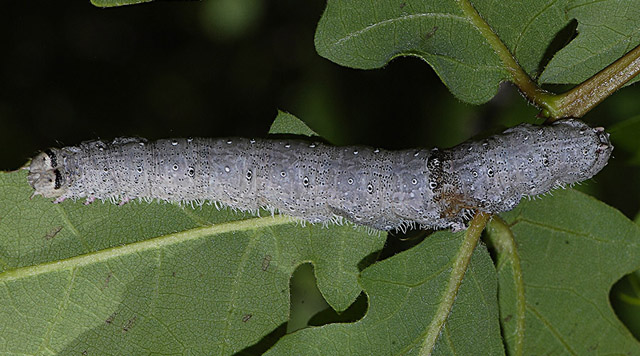Yellow-Orange Underwings: Smallest to Largest
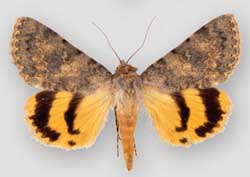
| Catocala frederici;
Frederic's Underwing: 40-52mm:
Fw blotchy yellow-brown, faint lines. Double am line has large central lobe.
Subrenifrom spot closed and pale.
Submarginal area orangey-yellow.
Hw yellow-orange, with outer black band broken, followed by flattened dot.
Thin inner black band angles almost 90 degree, truncated
well before im. Apex, large yellow area.
|
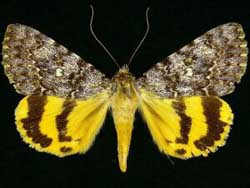
| Catocala caesia;
55mm. Fw blotchy blue-grey-brown with some lighter areas. Double am line dark & thick/diffuse. Distinct pm line, evenly dentate,
traced outwardly with thin white.
Reniform spot pale brown. Small subrectangular subreniform spot almost pure white, indented on inward side.
Hw bright yellow, unchecked yellow fringes. Inner black band
relatively thin, angles acutely toward im, bluntly truncated.
|
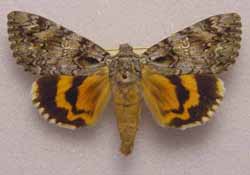
| Catocala ilia zoe male;
65mm. Fw light grey, considerable brown scaling. Double reniform spot has brown center, thinly outlined in black,
widely outlined in white,
thinly outlined in black. Subreniform spot indented on both inner & outer sides, just above tailed extension,
which may/may not be open.
Aml black, distinct, pointed, triangular shaped indentation just above im. Pml darker along upper half.
southern and western.
|
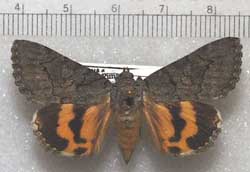
| Catocala chelidonia chelidonia;
45-50mm. Fw fuscous grey. Reniform, subreniform spots concolourous, with
srf closed, sometimes lighter and brown. Pm line thin, distinct, two upper teeth slightly produced.
Hw orangish. Black median band swollen near cell, angles 90 d toward, not to
im. Fringes off-white opp. orange, grey
opp. outer band. Some orange near apex inside thin, distinct sm line.
|
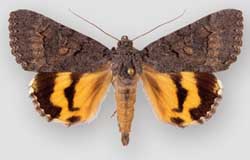
| Catocala chelidonia uniforma;
45-50mm. This subspecies has uniform gray forewings with substantially reduced
hoary mottling. The antemedial and postmedial forewing lines vary from inconspicuous
to very distinct, but weaken toward inner margin.
Known from mountains
of southeastern Arizona and southwestern New Mexico.
|
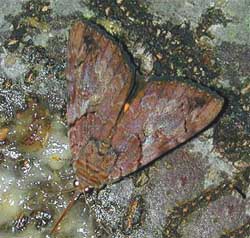
| ** 8774
muliercula;
Little Wife Underwing, 54-70mm
The black bands of the hindwings tend to be very wide and there is
considerable dark scaling along the inner margins. Hw
fringe is very dark as is the general reddish-brown ground colour of the forewings.
The forewing apex is preceded along the costa by a lighter,
grey-brown patch.
Steve Walter image. unconfirmed, ?? maybe in eastern counties
|
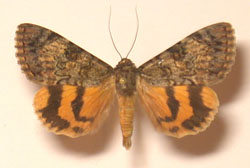
| Catocala desdemona;
55-70mm. Fw gc is light mottled grey with greenish blue cast. Double reniform spot
brown. Subreniform spot large, lighter brown, closed; tail extends to pm line.
Upper pml teeth moderately produced, next two teeth, not at all. Next produced, thick,
rounded, distinct inward loop below.
Hw ib turns 90 toward im. Ob broken; large orange apical area.
|
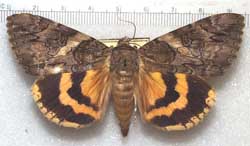
| Catocala piatrix dionyza;
68-84mm. Fw has light-colored band/bar extending from large, pale brown subreniform spot along am line to costa.
There is usually relatively dark area between reniform spot and pm line, wing veins tend to be dark and distinct there.
Hw fringe lightly barred, lighter than deeper orange on rest of wing.
|
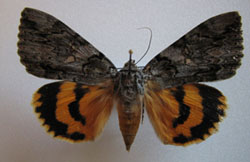
| neogama euphemia;
78-90mm:
Fw ground colour charcoal grey, often with bluish tinge. Am line thick,
dark along costa, extends in three more narrowly lined lobes, upper two notched,
toward, but not reaching midpoint of im. Pm line has two upper teeth elongated,
followed by much short tooth, longer tooth along extended line of subreniform spot.
|
Orange-Salmon-Red-Scarlet Underwings: Wingspans: 45-90mm
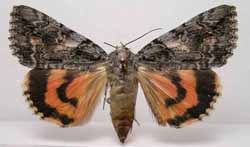
|
verrilliana; Verrill's Underwing;
45-60mm
Closed, subtriangular subreniform spot is large and
light in colour. Light patch runs from subreniform
diagonally to costa. Dark area on basal side of
am line and light patches between postmedian and subterminal lines
distinguish this species.
|
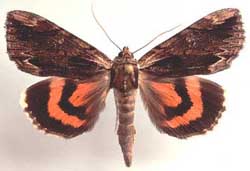
| ** 8857 Catocala ultronia;
Ultronia Underwing, wingspan: 50-63mm.
Fws typically gray-brown, with a distinct and very
dark inner margin and characteristic light brown patch, underscored
by very dark arc, near wingtip.
Underwings can be yellow to orange to salmon.
|
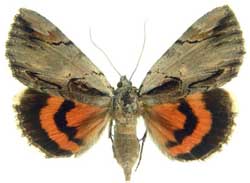
| ** 8857 Catocala ultronia form lucinda;
Ultronia Underwing, wingspan: 50-63mm.
In form lucinda most of the forewing
is bright grey. On all forms there is
extensive orange-salmon colouration on hw ventral surface,
and there is a dark discal lunule.
|
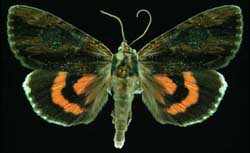
| Catocala ultronia,
form nigrescens, the Ultronia Underwing, wingspan: 50-63mm.
In the melanic form nigrescens, the dorsal forewing is very dark.
Even darker subapical arc, basal dash and dash near anal angle are still visible.
Dark basal hairs on hindwing.
Harold J. Vermes slide, used with permission from his son.
|
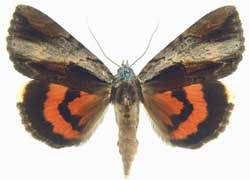
|
In form celia there is a wide, light grey band separating a dark region along inner margin and
a dark patch near the apex.
The ventral surface of forewings of all forms has a generous suffusion
of orange-salmon scales in the lower half of the median area.
|
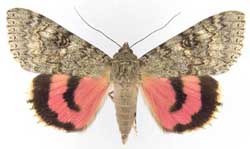
| Catocala hermia;
Hermia Underwing: 58-68mm; pinkish:
Fw almost uniform, grey-brown or clay coloured; thin, yet contrasting lines.
Distinct large double reniform spot. Large concolourous subrenifrom spot usually open.
Hw pinkish red, relatively even, narrow black bands. Inner black band ends before im.
Fringe white, checked, pink/red "bleeding" along outer band, near apex.
|
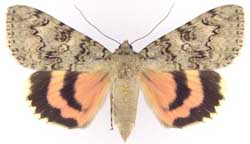
| ** 8808 luciana;
Luciana Underwing; 57-70mm.
Luciana has pale grey brown fw with very distinct am
& pm lines.
Subreniform spot has elongated narrow "tail" that seems to
open through postmedial line.
Hw inner black band does not reach inner margin.
Fringe is checked and paler (almost yellow) than
salmon ground colour.
|
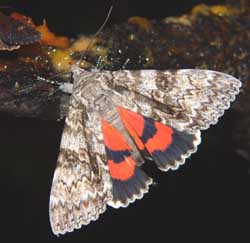
| ** 8821
semirelicta; Semirelict Underwing;
65-75mm
FW ground colour is whitish with dark lines and shadings.
Diffuse dark bar runs from center of basal area to outer margin a
few mm above anal angle. Note regular dentation of st line.
Hw inner black bar usually terminates well before
inner margin. The form "atala" has a forewing that is uniformly grey.
Unijuga is usually larger and has less contrasting black lines.
Inner black bar on unijuga usually reaches inner margin.
|
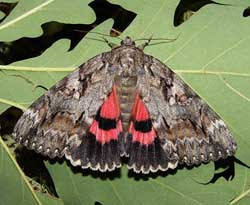
| aholibah;
80-90mm: Fw is mix of grey and brown, with preponderance of brown in subterminal area.
Double reniform spot has diffuse brown outline of inner oval. Subreniform spot is small,
distinctly outlined in black,
light coloured and does not connect to pm line. Upper two teeth of pm line are elongate
and are followed by relatively smooth line til next tooth below the subreniform spot.
Hindwing salmon or pinkish.
|
Reddish Underwings
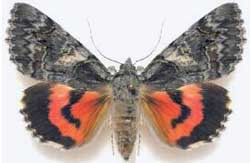
| Catocala ophelia;
Ophelia Underwing: 52mm:
Fw dark grey, am/pm lines are
relatively smooth except for two jagged spikes in pm
near apex. Considerable brown shading outside
subterminal line. Hw deep red, black
median band constricted in
center and terminating before im. Black
submarginal border is quite broad near apex. White fringe
heavily checked.
|
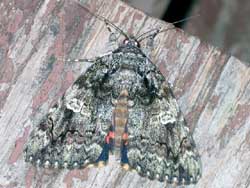
| ** 8801
Catocala ilia; Ilia;
65-82mm; GSMNP/TP/WAM;
Catocala ilia specimens come in several different forms.
Most have characteristic white area in and around
reniform spot. There is also a diffuse dark arc running from this
spot to just below apex.
Except in worn specimens and darkest forms,
the white dots near the outer margin of forewing are in character
with the overall "contrasting" appearance of this moth.
Joe Garris image.
|
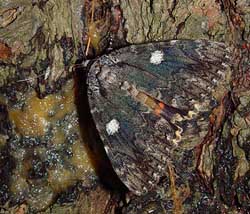
| ** 8801
Catocala ilia; Ilia; 65-82mm;
form conspicua
In this form the entire reniform spot is heavily suffused with white scaling on
an otherwise darker ground colour. Hence the form name "conspicua".
Tim Dyson image.
|
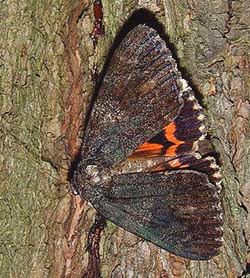
| ** 8801
Catocala ilia; Ilia;
form satanas
In this melanic form the entire forewing, including the reniform spot is very dark. Hence the form name "satanas".
The dark basal streak is still evident on this form.
Tim Dyson image.
|
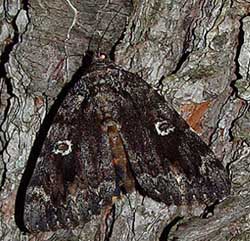
| ** 8801
Catocala ilia; Ilia;
form normani
In this semi-melanic form the entire forewing, excluding the reniform spot, is relatively dark.
The brownish, kidney-shaped center of the reniform spot is outlined in white.
The basal streak and subapical arc are still visible.
Tim Dyson image.
|
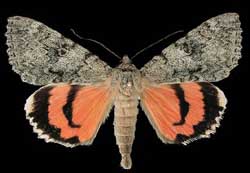
| Catocala junctura;
Joined Underwing; 67-85mm.
Fw is usually dark brownish-gray to evenly powdered
blue-grey w/o significant markings. Doubled reniform spot
often obscure. Thin, slightly darker am and pm
lines run from costa to im, not widely
spaced at im. Hw salmon/ orange-pink, narrow inner black band
turns in sharply, does not meet dark-haired im.
|
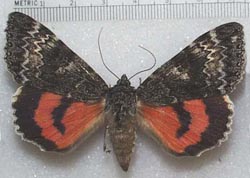
| Catocala grotiana;
Grote's Underwing: 70-80mm:
The white outlines outside the postmedial and inside the subterminal lines make this species stand out.
The hindwing inner black band is even and relatively thin and terminates well before the inner margin.
The fringe is heavily checked and charcoal grey along the inner margin.
Hindwings can be orange or red.
|
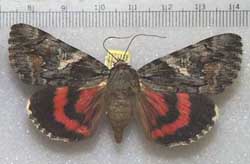
| ** 8833 violenta
Violent Underwing (70-80mm): Two elongated, well-defined spikes high in the postmedial line
extend to subterminal line. Next tooth is very short. There is considerable brown shading on
the forewing between the pme and st lines.
Subreniform spot is light with light bar extending obliquely to
the costa.
|
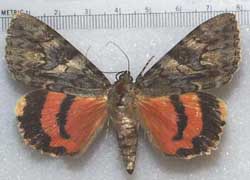
| Catocala jessica;
Jessica Underwing: 75mm: Fw is bluish grey with some brown scaling. Am line is irregular, meets i m almost at midpoint.
Pm line has one upper tooth produced, second is much less so. Third is little more than a sharp point
on smooth curve to fourth tooth, somewhat produced over opening of large subreniform spot.
Reniform spot is double and dark in darker region of median area.
|
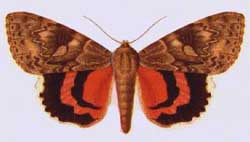
| Catocala electilis;
Fw dark grey. Black pm line thin but distinct; two upper teeth not greatly produced.
Reniform spot dark brown; large, pork-chop shaped subreniform spot lighter brown
extends to pm line. Brown shading in subterminal area.
Hw salmon (orange to red).
|
Medium-Large Pink Underwings: Wingspans: 70-95mm
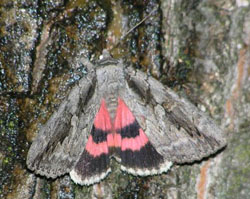
|
** 8834 amatrix
Sweetheart Underwing; (wingspan 75-95mm).
Very skittish, frequently hides in caves, under
bridges, under tree bark, etc. by day, resting with head down.
Hw patterning and colouration similar to that of
C. concumbens, but large size (wingspan 75-95mm)
and dark bar running from basal area to just below apex
distinguishes C. amatrix. See large
Catocala amatrix courtesy of
Joan F. Rickert.
|
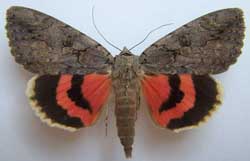
|
** 8834 amatrix form selecta
Sweetheart Underwing; (wingspan 75-95mm)
Very skittish and frequently hides in caves, under
bridges, under tree bark, etc. by day, resting with head down.
Several forms, including selecta (to the left)
which lacks dark bar on forewing. Hesseli: melanic form;
pallida: very pale form.
|
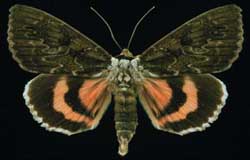
|
** 8834 amatrix form hesseli
Sweetheart Underwing; (wingspan 75-95mm)
Very skittish and frequently hides in caves, under
bridges, under tree bark, etc. by day, resting with head down.
The melanic form hesseli is very dark and displays dark basal hairs in the hindwing.
|
|
Large Black Underwings (Banded): Wingspans: 70-80mm
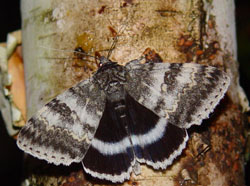
| ** 8803 Catocala relicta
;
Forsaken, White, Relict; 70-80mm:
Considerable variation with regard to black/white
concentrations on fws.
Typical specimens have basal and subterminal areas with
blackish scales.
Black hws, with brilliant even white inner band and
white fringe, are distinctive. June until October.
|
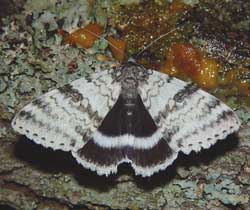
| ** 8803 Catocala relicta
;
Forsaken, White, Relict; 70-80mm:
Considerable variation with regard to black/white
concentrations on fws.
Form clara: basal and subterminal
areas predominantly white.
Typical specimens have basal and subterminal areas with
blackish scales. Black hws, with brilliant even white inner band and
white fringe, are distinctive. June until October.
|
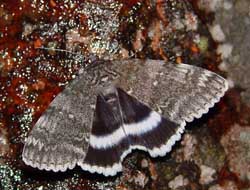
| ** 8803 Catocala relicta
;
Forsaken, White, Relict; 70-80mm:
Considerable variation with regard to black/white
concentrations on fws.
Form phrynia:
evenly dusted with grey over entire forewing.
Typical specimens have basal and subterminal areas with
blackish scales. Black hws, with brilliant even white inner band and
white fringe, are distinctive. June until October, poplars and willows
|
|
|
